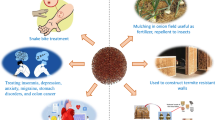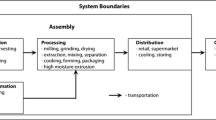Abstract
The food safety of stacked trait genetically modified (GM) maize GH5112E-117C containing insect-resistance gene Cry1Ah and glyphosate-resistant gene G2-aroA was evaluated in comparison to non-GM Hi-II maize fed to Sprague-Dawley rats during a 90-day subchronic feeding study. Three different dietary concentrations (12.5, 25 and 50 %, w/w) of the GM maize were used or its corresponding non-GM maize. No biologically significant differences in the animals’ clinical signs, body weights, food consumption, hematology, clinical chemistry, organ weights and histopathology were found between the stacked trait GM maize groups, and the non-GM maize groups. The results of the 90-day subchronic feeding study demonstrated that the stacked trait GM maize GH5112E-117C is as safe as the conventional non-GM maize Hi-II.

Similar content being viewed by others
Abbreviations
- USDA:
-
United States Department of Agriculture
- GM:
-
Genetically modified
- Bt:
-
Bacillus thuringiensis
- SPF:
-
Specific pathogen free
- GMOs:
-
Genetically modified organisms
- OECD:
-
Organization for Economic Cooperation and Development
- EU:
-
European Union
References
Appenzeller LM, Malley L, Mackenzie SA, Hoban D, Delaney B (2009) Subchronic feeding study with genetically modified stacked trait lepidopteran and coleopteran resistant (DAS-O15O7-1xDAS-59122-7) maize grain in Sprague-Dawley rats. Food Chem Toxicol 47:1512–1520
Barros E, Lezar S, Anttonen MJ, van Dijk JP, Rohlig RM, Kok EJ, Engel KH (2010) Comparison of two GM maize varieties with a near-isogenic non-GM variety using transcriptomics, proteomics and metabolomics. Plant Biotechnol J 8:436–451
Bravo A, Gill SS, Soberón M (2007) Mode of action of Bacillus thuringiensis Cry and Cyt toxins and their potential for insect control. Toxicon 49:423–425
Cao GY, Liu YJ, Zhang SX, Yang XW, Chen RR, Zhang YW, Liu Y, Wang JH, Lin M, Wang GY (2012) A novel 5-enolpyruvylshikimate-3-phosphate synthase shows high glyphosate tolerance in Escherichia coli and tobacco plants. PLoS One 7(6):1–11
Chinese Standard 14924.3-2001 (2001) Mixed feed of experimental animals mice and rats. Standards Press of China, Beijing
Chinese Standard GB/T5009.3-2003 (2003) Inspection of grain and oilseeds: methods for determination of moisture. Standards Press of China, Beijing
Chinese Standard GB/T5009.4-2003 (2003) Inspection of grain and oilseeds: methods for determination of ash. Standards Press of China, Beijing
Chinese Standard GB/T5009.5-2003 (2003) Inspection of grain and oilseeds: methods for determination of crude protein. Standards Press of China, Beijing
Chinese Standard GB/T5009.6-2003 (2003) Inspection of grain and oilseeds: methods for determination of crude fat. Standards Press of China, Beijing
Chinese Standard GB/T5009.10-2003 (2003) Inspection of grain and oilseeds: methods for determination of crude fiber. Standards Press of China, Beijing
Chinese Standard GB/T5009.87-2003 (2003) Inspection of grain and oilseeds: methods for determination of phosphorus in foods. Standards Press of China, Beijing
Chinese Standard GB/T5009.92-2003 (2003) Inspection of grain and oilseeds: methods for determination of calcium in foods. Standards Press of China, Beijing
Coll A, Nadal A, Rossignol M, Puigdomenech P, Pla M (2011) Proteomic analysis of MON810 and comparable non-GM maize varieties grown in agricultural fields. Transgenic Res 20:939–949
De Schrijver A, Devos Y, Van den Bulcke M, Cadot P, De Loose M, Reheul D, Sneyers M (2007) Risk assessment of GM stacked events obtained from crosses between GM events. Trends Food Sci Technol 18:101–109
Dun BQ, Wang XJ, Lu W, Chen M, Zhang W, Ping SZ, Wang ZX, Zhang BM, Lin M (2014) Development of highly glyphosate-tolerant tobacco by coexpression of glyphosate acetyltransferase gat and EPSPS G2-aroA genes. Crop J 2:164–169
Green JM (2009) Evolution of glyphosate-resistant crop technology. Weed Sci 57:108–117
Green JM (2012) The benefits of herbicide-resistant crops. Pest Manag Sci 68:1323–1331
James C (2010) Global status of commercialized biotech/GM crops: 2010. International Service for the Acquisition of Agri-biotech Applications (ISAAA), Ithaca
Kawahigashi H, Hirose S, Ohkawa H, Ohkawa Y (2007) Herbicide resistance of transgenic rice plants expressing human CYP1A1. Biotechnol Adv 25:75–84
Li XY, Li SY, Lang ZH, Zhang J, Zhu L, Huang DF (2013) Chloroplast-targeted expression of the codon-optimized truncated cry1Ah gene in transgenic tobacco confers a high level of protection against insects. Plant Cell Rep 32:1299–1308
Li XY, Lang ZH, Zhang J, He KL, Zhu L, Huang DF (2014) Acquisition of insect-resistant transgenic maize harboring a truncated cry1Ah gene via agrobacterium-mediated transformation. J Integr Agric 13:937–944
McComas KA, Besley JC, Steinhardt J (2014) Factors influencing U.S. consumer support for genetic modification to prevent crop disease. Appetite 78:8–14
NY/T1102-2006 (2006) Safety assessment of genetically modified plant and derived products 90-day feeding test in rats. Standards Press of China, Beijing
OECD (1998) Repeated dose 90-day oral toxicity study in rodents. OECD Guideline for the Testing of Chemicals. Guideline 408. Organization for Economic Cooperation and Development (OECD), Paris
Paul L, Angevin F, Collonnier C, Messean A (2012) Impact of gene stacking on gene flow: the case of maize. Transgenic Res 21:243–256
Qaim M (2009) The economics of genetically modified crops. Annu Rev Resour Econ 1:665–694
Qi XZ, He XY, Luo YB, Li SY, Zou SY, Cao SS, Tang MZ, Delaney B, Xu WT, Huang KL (2012) Subchronic feeding study of stacked trait genetically-modified soybean (3O5423 × 40-3-2) in Sprague-Dawley rats. Food Chem Toxicol 50:3256–3263
Shin KS, Suh SC, Lim MH, Woo HJ, Lee JH, Kim HY, Cho HS (2013) Event-specific detection system of stacked genetically modified maize by using the multiplex-PCR technique. Food Sci Biotechnol 22:1763–1772
Song Y, Liang CL, Wang W, Fang J, Sun NN, Jia XD, Li N (2014) Immunotoxicological evaluation of corn genetically modified with Bacillus thuringiensis Cry1Ah Gene by a 30-day feeding study in BALB/c Mice. PLoS One 9(2):1–11
Xue J, Liang GM, Crickmore N, Li HT, He KL, Song FP, Feng X, Huang DF, Zhang J (2008) Cloning and characterization of a novel Cry1A toxin from Bacillus thuringiensis with high toxicity to the Asian corn borer and other lepidopteran insects. FEMS Microbiol Lett 280:95–101
Zhu YX, He XY, Luo YB, Zou SY, Zhou X, Huang KL, Xu WT (2013) A 90-day feeding study of glyphosate-tolerant maize with the G2-aroA gene in Sprague-Dawley rats. Food Chem Toxicol 51:280–287
Acknowledgments
This work was supported by Genetically Modified Organisms Breeding Major Projects of PR China Grant 2014ZX0801103B. The authors also give the best appreciation to the Beijing Origin Seed Technology Inc. (Beijing, China) for providing the GM maize GH5112E-117C and the near-isogenic non-GM maize Hi-II.
Author information
Authors and Affiliations
Corresponding author
Ethics declarations
Conflict of interest
The authors declare no conflicts of interest.
Rights and permissions
About this article
Cite this article
Han, S., Zou, S., He, X. et al. Potential subchronic food safety of the stacked trait transgenic maize GH5112E-117C in Sprague-Dawley rats. Transgenic Res 25, 453–463 (2016). https://doi.org/10.1007/s11248-016-9944-6
Received:
Accepted:
Published:
Issue Date:
DOI: https://doi.org/10.1007/s11248-016-9944-6




